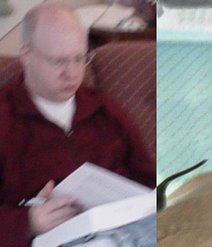I am coming back to study the historical context of the New Testament - the first two centuries BCE. Here is a brief summary, using the 25-year grid method. Beginning this period in 200 and ending at the year 1 gives us eight blocks of time. I Maccabees covers block 2-3, while II Maccabees starts in block 1 and ends in block 2.
Block 1 (200-175) - Israel is under Syrian Rule.
Block 2 (175-150) - Leadup to the Maccabean revolt. Antiochus IV Epiphanes takes the throne in 175. He desecrates the Jerusalem temple, leading to the Maccabean revolt, which takes place about half-way through the block (167). Matthias (the first of the Hasmoneans) and his son, Judas lead the movement in turn and are both killed. The clensing of the temple from pagan influence (prompting the feast of dedication, or Hannukkah) occurs in 164. Jonathan, Judas' brother, leads the movement for the last ten years of this block and the first half of the next.
Block 3 (150-125) - The Maccabean struggle. Jonathan is killed, followed by his brother,Simon. I Maccabees ends with John Hyrcanus, Simon's son, becoming high priest (134), which he held through the next block.
Block 4 (125-100) - Hasmonean compromise. Hyrcanus dies and is followed by his son, Aristobulus I, who adds the title 'King' to his position as high priest. He reigns until nearly the end of the block (103). Both Hyrcanus and Aristobulus make concessions to Hellenistic culture which are detested by orthodox jews.
Block 5 (100-75) - Hasmonean Decline. Aristobulus's brother, Alexander Jannaeus, dominates this block, as king from 103-76.
Block 6 (75-50) - Hasmonean End. Alexander Jannaeus' wife takes power during the first half (until 66), followed by civil war between her sons, Hyrcanus II and Aristobulus II.
Block 7 (50-25) - Roman influence. Antipater, the first of the Herods, compells the Romans (under Pompey) to depose of the Hasmoneans altogether. He is assassinated early in the block, when his son, Herod I takes control. Herod reigns for the second half of this block (37 onward) until nearly the end of the next block!
Block 8 (25-0*) - Herod's glory. Herod has all sorts of building projects in Judea, repairing the Jerusalem temple, building the port-city of Caesarea, and countless temples, fortresses, and palaces. Herod I reigns until 4 BCE, when his son, Archaelaus briefly has power.
With a bit more work, I could fill out the next three:
Block 9 (0*-25) - Romans in power. A series of governors rule Judea.
Block 10 (25-50) - Romans still in power. Unrest grows.
Block 11 (50-75) - Destruction. Jerusalem razed in the year 70.
I should probably extend through block 14, with the Bar Kockhba revolt. Right now I'm trying to get a grip on blocks 1-8, which is what prompted this series to begin with. I am aware that I oversimplify things, but I think the clarity that I gain outweighs the little bit I lose from oversimplifying. And, of course, these years are totally arbitrary - and yet they seem to work pretty well. Let me know what you think.
*There is no such thing as year 0, since the people who first made the calander didn't get the concept. Technically you have to skip from 1BC to AD1. I noted earlier that the years are guides, not exact dates, so I use numbers that are convenient. Also, I use BC and BCE interchangably, as well as AD and CE. There is little rhyme or reason as to when I use one or the other. I probably should just pick one and stick to it.
Wednesday, September 12, 2007
Subscribe to:
Post Comments (Atom)


2 comments:
This is probably opening up a really, really big can of worms, but... If I happen to find the time to actually read some, what books would you recommend to get a good idea of the first two centuries BCE? That's one time period I've never known much about. Oh, yeah, this is Ben, but it won't let me sign in as me for some reason. So I'm anonymous.
Thanks for your comment Ben. Sorry for the delay, but things have just been crazy and my blog has suffered as a result.
I think the best writing on the topic for the light it sheds on New Testament interpretation is Part III of N.T. Wright's The New Testament and the People of God, "First Century Judaism Within the Greco-Roman World."
The three standard (and massive) books on the topic are S. Safrai's The Jewish People in the First Century (1974), E. Schürer's The History of the Jewish People in the Age of Christ (updated by Geza Vermes in 1973), and W.D. Davies's The Cambridge History of Judaism, Vol. 2.
An easy place to start is with a good New Testament Survey book, which will usually have at least a chapter on this history. Also, it is well worth it to read I & II Maccabees for yourself if you have not done so. The easiest place to find them is in a Bible translation that includes the apocrypha (typically NRSV or NAB).
Post a Comment